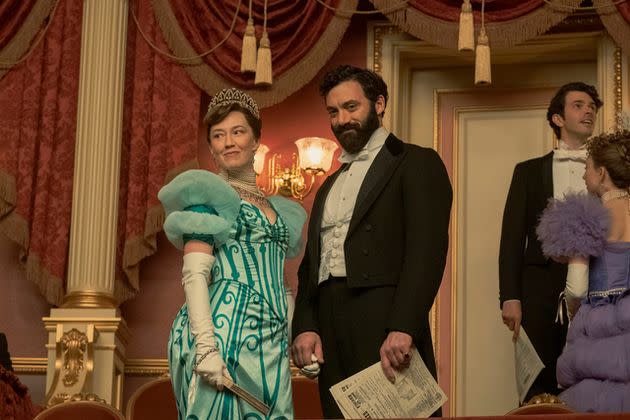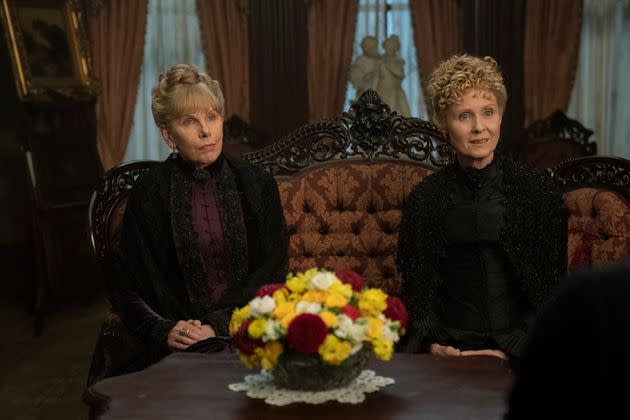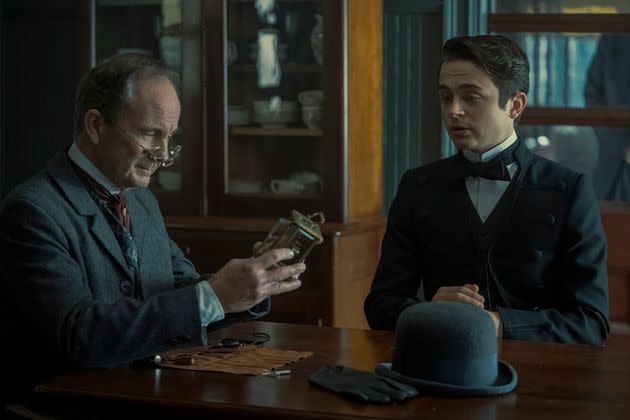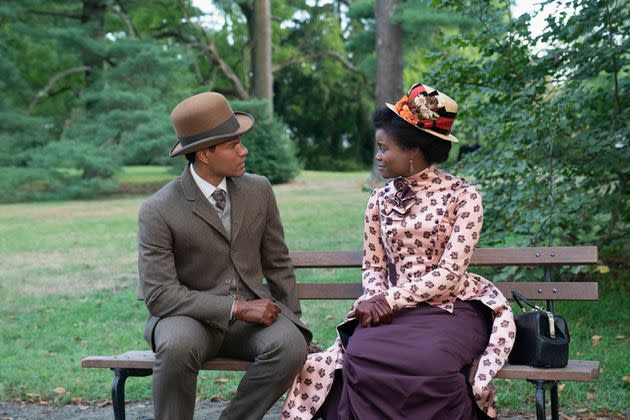'The Gilded Age' Could Be America's Premier Period Drama. Here's What It Needs.

Carrie Coon (left) and Morgan Spector in "The Gilded Age."
On Sunday night, as the Season 2 finale of “The Gilded Age” was set to stream on Max, I was shocked when I found myself watching the clock, waiting for the episode to drop, to see what would happen next in the battle between old and new money on New York’s Fifth Avenue in the 1880s. Who would win the season-long war of the opera houses between Bertha Russell (Carrie Coon), the show’s embodiment of new money, and Mrs. Astor (Donna Murphy), the gatekeeper of old-moneyed society? Would Bertha’s patronage of the Metropolitan Opera displace the historic prominence of the Academy of Music, where securing a box had historically cemented one’s social acceptance?
My investment in the outcome was a large departure from how I’d felt about the HBO show since its premiere almost two years ago. In fact, when the pilot first aired, I didn’t even finish it.
At the time, my inability to suffer through the show’s setup surprised me. I didn’t care about the Rockefeller-esque Russell family moving into their opulent mansion on Fifth Avenue and across the street from the old-moneyed Agnes van Rhijn (Christine Baranski) and her spinster sister, Ada Brook (Cynthia Nixon), who have agreed to take in niece Marian Brook (Louisa Jacobson) after her father dies and leaves her penniless.

Christine Baranski (left) and Cynthia Nixon in "The Gilded Age."
What made this even more surprising is that I am a lifelong lover of period dramas. I was a middle school girl who used to spend entire Saturday afternoons rewatching the over-four-hour 1995 BBC version of “Pride and Prejudice” on DVD. In college, I was the only young millennial I knew tuning in to “Downton Abbey” (before it was popular). Now, I’m the only 32-year-old I know with a PBS Passport membership, subscribing monthly, so I get early access to shows like “Call the Midwife,” “All Creatures Great and Small” and my absolute favorite miniseries, “Sanditon,” which ended in the spring. And, yes, I also love more sensational and popular period dramas like Netflix’s “Bridgerton” and “Queen Charlotte.”
So, why did I find “The Gilded Age” so unwatchable? The intricate sets, accomplished cast and extravagant costumes didn’t compensate for the plot’s tedious pace or dull storylines, and I wasn’t alone in feeling this way. In its first season, “The Gilded Age” became a show to hate-watch. However, unlike those writing online about how “enthrallingly awful” the series was, I couldn’t bring myself to finish that first episode, let alone tune in to the rest of the season.
It wasn’t until this month when I was recovering from a major, painful surgery and desperate for content that I found myself giving it another try. I ended up binge-watching my way through Season 1 and the first six episodes of Season 2. Unlike my first attempt to watch the show, I couldn’t look away — not because it was addictively bad, but because I wanted to answer a question: Why isn’t “The Gilded Age” better?
In the first season, that answer is obvious: the writing, the plotting, the pacing. Despite being written and co-produced by Julian Fellowes, the mastermind behind “Downton Abbey,” the first season of “The Gilded Age” falls short. This is especially true when compared with popular period pieces of the past decade.
The intricate sets, accomplished cast and extravagant costumes didn’t compensate for the plot’s tedious pace or dull storylines, and I wasn’t alone in feeling this way.
Unlike Fellowes’ “Downton Abbey,” it doesn’t elicit the same emotional connection between the characters and the audience. The post-Edwardian show uses the “upstairs” Crawley family and its “downstairs” servants to provide an intricate portrayal of personal lives being shaped by big societal changes — both technological and social. In “The Gilded Age,” which also has an upstairs-downstairs cast, the storylines lack emotions and stakes. I cared as little about Gladys Russell (Taissa Farmiga) coming out into society — one of the season’s main conflicts — as I did about Turner (Kelley Curran), Bertha’s maid, trying to seduce her husband, George Russell (Morgan Spector).
Plotlines that did have the potential to be interesting weren’t developed and moved too slowly over the course of the season to maintain my interest. This is especially true for the downstairs cast, including the awkward attempt at a romance between footman Jack (Ben Ahlers) and maid Bridget (Taylor Richardson), and the not-at-all-compelling revelation that the Russells’ “French” chef, Monsieur Baudin (Douglas Sills), is actually from Kansas. These shortfalls also apply to the upstairs cast’s lackluster storylines, including Larry Russell (Harry Richardson) wanting to study to be an architect instead of working for his father’s business.
Another area in which the show severely struggles is its lack of romance, setting it apart from the heightened reimagining of the Regency era in “Bridgerton” and “Queen Charlotte.” Those shows both depend upon the chemistry of the couples — the slow burn of enemies becoming lovers in the former, and the longevity of that passion in the latter. But “The Gilded Age” has neither.
If Bertha is supposed to carry the plot on her side of the street, then Marian is intended to hold that weight on hers. A huge part of the first season’s story is that Marian agrees to elope with Tom Raikes (Thomas Cocquerel), a young lawyer from Pennsylvania who moves to New York with no social standing. But the two have no on-screen chemistry, and Marian’s willingness to give up everything for him is nonsensical and undermines the independence that the show so desperately wants her to have.
For me, this goes back to the pacing problem. British period dramas like “Sanditon” know how to build suspense. One romantic lead may do nothing more than row the other in a boat or pick up her dropped glove, but the way their hands graze on the wooden oars or their eyes lock when that glove is returned creates enough tension to carry an entire episode. Most importantly, those small scenes become the big ones, building toward a believable, passionate love story.
Marian’s love life needs this type of period-appropriate fuel. So does Bertha and George’s. While the Russells’ steadfast dedication to each other’s social and professional goals makes their relationship the one with the most potential to be interesting, it isn’t enough. The show doesn’t develop the why behind their actions — the reason they are so loyal to each other.
Though these faults largely remain in the second season, it is still better than the first. The writing is sharper, the subplots are more enjoyable (especially the one with Jack and his alarm clock), and the historic events, like the opening of the Brooklyn Bridge, and the cameos of people like Oscar Wilde and Booker T. Washington kept my eyes on the screen.

Ben Ahlers (right) as Jack in "The Gilded Age."
For me, the fault with the second season lies primarily in that it is better, because that makes it even more aggravating that it is not good. The show has all the ingredients to be captivating, award-winning, prestige TV. But more importantly, the parallels between “The Gilded Age” and today — the economic, racial, gender and ethnic inequalities that stratify society in the late 19th century — give it the potential to become meaningful social commentary.
This is most present in a few of the second season storylines: the steelworkers striking against George’s company, the growing barriers facing Peggy Scott (Denée Benton) and the middle-class Black community, and Marian’s job as a teacher. My issue with all three is where the lens of the camera falls.
With the strike, I want more time spent on the extreme poverty of the workers building George’s fortune, on the flicker of human empathy in his eyes when he tells the troops not to shoot at the men and child laborers striking outside his factory.
Instead of sending Peggy south of the Mason-Dixon Line to report on the Tuskegee Institute (where she and her editor barely evade a violent mob), I want to see her stay in New York. While her time in Alabama and harrowing escape are among the season’s more captivating storylines, they represent an appalling part of history with which many of us are familiar. Instead, I want more time spent on the growing institutional barriers that she and the Black community in Brooklyn face — like the school board’s attempt to close three Black schools. I want to see how systemic inequalities that are overt become (almost) invisibly woven into our history. I want to zoom in on the way Peggy feels like the board’s decision to close only one of the schools is a loss, not a victory.
Similarly, I want to see the greater complexity that exists in Marian’s desire for independence. When Marian ends her engagement to Cousin Dashiell (David Furr), she says they don’t want the same things, and she hopes to make a difference before she settles down. However, there is little attention paid to what kind of difference. There is no acknowledgment that her inability to work is not only what her husband wants but also the law at the time. I want to see the harsh reality of what it means to be a woman at that time and where progress is happening then, especially in regard to women’s suffrage. The show desperately wants Marian to be as strong and independent as Peggy, but it doesn’t let her leave her sheltered reality long enough to find the opportunity.

Sullivan Jones (left) and Denée Benton in "The Gilded Age."
The most interesting statement that the show makes about society occurs in the final minutes of the season, after Bertha has won the opera battle. Sitting in the center box, moments after the Duke of Buckingham (Ben Lamb) enters to solidify her victory, Mrs. Fish (Ashlie Atkinson) says, “American society has been reinvented tonight, and you are at the very heart of it.” The reality is that Bertha may be dismantling one system of social stratification, but it is only for the purpose of creating another because, for the majority of New Yorkers, attending the Metropolitan Opera is just as unattainable. Nothing highlights this irony more than the fact that Bertha’s success hinges upon the presence of a duke whose inherited title gives more social capital to her new money.
This tension is where “The Gilded Age” can shine in Season 3. Using the threads that have been woven this season, the show has the opportunity to demonstrate how particularly American it is to break down barriers only to erect new ones.
After all, while the characters in this American period piece appear to have more mobility than those in a British one, there are far too many systemic barriers that prevent them from finding their bootstraps. If the next season of “The Gilded Age” can improve its pacing, plot and romantic storytelling, and chooses to explore those subtle tensions that already exist, then it has the opportunity to create not just a uniquely American period piece, but — dare I say it — a good television show.
